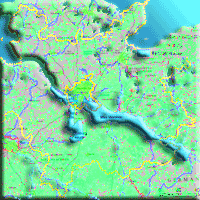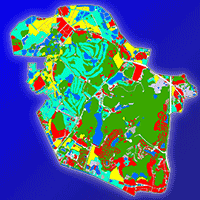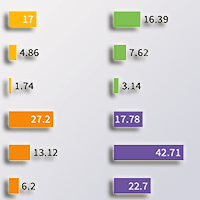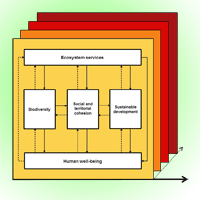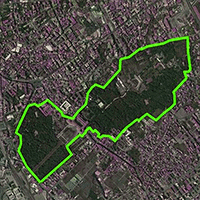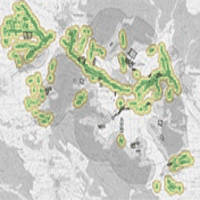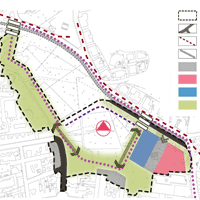The aim of the study was to determine the willingness-to-pay (WTP) in exchange for recreation, to determine the dependency between the frequency of visits and willingness of forest users to make contributions for urban forests and the appearance of the forest, as well as the sociological characteristics of the respondents. The research was carried out on the example of the medium-sized city of Tarnów, southern Poland. To this aim, a survey was conducted on a group of 309 adult respondents inhabitants of Tarnów city and city’s surroundings settlements. For statistical analysis, the Classification And Regression Trees (CART) method was used to determine the dependency between the declared contributions and the characteristics of respondents, and the Principal Components Analysis for examining the dependency between WTP and the appearance (structure) of the forest. The dependency between the frequency of visits to urban forests and the demographics was analysed by chi-square test and one-way analysis of variance. The results showed that 97% of respondents are willing to make payments for urban forests, the amount of which differed depending on their place of residence, education, and age. Also, the vast majority of respondents make their WTP contributions dependent on the appearance of the forest. This applies in particular to a multi-stratum, multi-species forest with the undergrowth and recreational infrastructure. In addition, the frequency of visits to the area is affected by gender and place of residence. The obtained results are especially important for the recreation function of urban forests including willingness of inhabitants in Tarnów city and surroundings settlements.
Keywords
, , , , ,
Citation
Mandziuk A, Fornal-Pieniak B, Ollik M (2021). The willingness of inhabitants in medium-sized city and the city’s surroundings settlements to pay for recreation in urban forests in Poland. iForest 14: 483-489. - doi: 10.3832/ifor3758-014
Academic Editor
Raffaele Lafortezza
Paper history
Received: Jan 20, 2021
Accepted: Aug 26, 2021
First online: Oct 27, 2021
Publication Date: Oct 31, 2021
Publication Time: 2.07 months
© SISEF - The Italian Society of Silviculture and Forest Ecology 2021
Open Access
This article is distributed under the terms of the Creative Commons Attribution-Non Commercial 4.0 International (https://creativecommons.org/licenses/by-nc/4.0/), which permits unrestricted use, distribution, and reproduction in any medium, provided you give appropriate credit to the original author(s) and the source, provide a link to the Creative Commons license, and indicate if changes were made.

Breakdown by View Type
(Waiting for server response...)
Article Usage
Total Article Views: 31536
(from publication date up to now)
Breakdown by View Type
HTML Page Views: 26803
Abstract Page Views: 2110
PDF Downloads: 2079
Citation/Reference Downloads: 0
XML Downloads: 544
Web Metrics
Days since publication: 1508
Overall contacts: 31536
Avg. contacts per week: 146.39
Article Citations
Article citations are based on data periodically collected from the Clarivate Web of Science web site
(last update: Mar 2025)
Total number of cites (since 2021): 5
Average cites per year: 1.00
Publication Metrics
by Dimensions ©
Articles citing this article
List of the papers citing this article based on CrossRef Cited-by.
(1)
Abedi R, Abedi T (2020)Evaluation indicators for sustainable urban forest in Tabriz City, Iran. Forestry Ideas 26 1 (59): 65-76.
Online |
Gscholar
(2)
Adams DC, Soto JR, Lai J, Escobedo FJ, Alvarez S, Abu Kibria SMG (2020)Public preferences and willingness to pay for invasive forest pest prevention programs in urban areas. Forests 11 (10): 1056.
CrossRef |
Gscholar
(3)
Arnberger A, Schneider IE, Eder R, Choi A (2020)Differences in urban forest visitor preferences for emerald ash borer-impacted areas. Forestry 93 (2): 225-238.
CrossRef |
Gscholar
(4)
Barrio M, Loureiro ML (2010)A meta-analysis of contingent valuation forest studies. Ecological Economics 69 (5): 1023-1030.
CrossRef |
Gscholar
(5)
Bartczak A (2015)The role of social and environmental attitudes in non-market valuation. An application to the Bialowieza Forest. Forest Policy and Economics 50: 357-365.
CrossRef |
Gscholar
(6)
Bateman IJ (1996)Household willingness to pay and farmers willingness to accept compensation for establishing a recreational woodland. Journal of Environmental Planning and Management 39 (1): 21-44.
CrossRef |
Gscholar
(7)
Bertram C, Larondelle N (2017)Going to the woods is going home: recreational benefits of a larger urban forest site - A travel cost analysis for Berlin, Germany. Ecological Economics 132: 255-263.
CrossRef |
Gscholar
(8)
Carrus G, Panno A, Aragones JI, Motta R, Tonon G, Sanesi G (2020)Public perceptions of forests across Italy: an exploratory national survey. iForest - Biogeosciences and Forestry 13: 323-328.
CrossRef |
Gscholar
(9)
Centrum Informacyjne Lasów Panstwowych (2012)Zasady Hodowli Lasu [Rules of silviculture]. Panstwowe Gospodarstwo Lesne Lasy Panstwowe, Centrum Informacyjne Lasów Panstwowych, Warszawa, Poland, pp. 55. [in Polish]
Online |
Gscholar
(10)
Chen B, Qi X (2018)Protest response and contingent valuation of an urban forest park in Fuzhou City, China. Urban Forestry and Urban Greening 29: 68-76.
CrossRef |
Gscholar
(11)
Chen S, Wang Y, Ni Z, Zhang X, Xia B (2020)Benefits of the ecosystem services provided by urban green infrastructures: differences between perception and measurements. Urban Forestry and Urban Greening 54: 126774.
CrossRef |
Gscholar
(12)
Czajkowski M, Bartczak A, Budzinski W, Giergiczny M, Hanley N (2016)Preference and WTP stability for public forest management. Forest Policy and Economic 71: 11-22.
CrossRef |
Gscholar
(13)
De Meo I, Paletto A, Cantiani MG (2015)The attractiveness of forests: preferences and perceptions in a mountain community in Italy. Annals of Forest Research 58 (1): 145-156.
CrossRef |
Gscholar
(14)
Dhakal B, Yao RT, Turner JA, Barnard T (2012)Recreational users’ willingness to pay and preferences for changes in planted forest features. Forest Policy and Economics 14: 34-44.
CrossRef |
Gscholar
(15)
EUROSTAT (2019)Eurostat regional yearbook 2019. Directorate-General for Communication, European Commission, Brussels, Belgium, web site.
Online |
Gscholar
(16)
Fornal-Pieniak B, Ollik M, Zaras-Januszkiewicz E, Zarska B (2014)Diversity of ancient woody species in urban forests. Folia Forestalia Polonica A 56 (2): 116-117.
CrossRef |
Gscholar
(17)
Fornal-Pieniak B, Zarska B, Zaras-Januszkiewicz E (2018)Natural evaluation of landscape in urban area comprising Bielanski Forest nature reserve and surroundings, Warsaw, Poland. Directions for landscape protection and planning. Annals of Warsaw University of Life Sciences - SGGW 50 (4): 327-338.
CrossRef |
Gscholar
(18)
Fornal-Pieniak B, Ollik M, Schwerk A (2019)Impact of different levels of anthropogenic pressure on the plant species composition in woodland sites. Urban Forestry and Urban Greening 38: 295-304.
CrossRef |
Gscholar
(19)
Giergiczny M, Valasiuk S, De Salvo M, Signorello G (2014)Value of forest recreation. Meta-analyses of the European valuation studies. Economics and Environmental 4 (54): 76-83.
Online |
Gscholar
(20)
Golos P (2018)Social and economic aspects of non-productive functions of forests and forest management - Results of public opinion polls. Papers and Monographs, Forest Research Institute, Sekocin Stary, Poland, pp. 150-165.
Gscholar
(21)
Hammit WE, Patterson ME (1993)Use patterns and solitude preferences of shelter campers in Great Smoky Mountains National Park, USA. Journal of Environmental Management 38 (1): 43-53.
CrossRef |
Gscholar
(22)
Howley P (2011)Landscape aesthetics: assessing the general publics’ preferences towards rural landscapes. Ecological Economics 72 (C): 161-169.
CrossRef |
Gscholar
(23)
Janeczko E, Woznicka M, Tomusiak R, Dawidziuk A, Kargul-Plewa D, Janeczko K (2017)Social preferences regarding recreation in forests of the Mazowiecki Landscape Park in 2000 and 2012. Sylwan 161 (5): 422-429. [in Polish]
CrossRef |
Gscholar
(24)
Kikulski J (2009)Model of recreational development of forests in the lake districts. Studia i Materialy Centrum Edukacji Przyrodniczo-Lesnej w Rogowie 11 4 (23): 165-171. [in Polish]
Gscholar
(25)
Lasy Panswowe (2012)Instrukcja urzadzania lasu [Forest management instruction]. Dyrekcja Generalna Lasów Panstwowych, Warsaw, Poland, web site. [in Polish]
Online |
Gscholar
(26)
Lindhjem H (2007)20 years of stated preference valuation of non-timber benefits from Fennoscandian forests: a meta-analysis. Journal of Forest Economics 12: 251-277.
CrossRef |
Gscholar
(27)
Majumdar S, Deng J, Zhang Y, Pierskalla C (2011)Using contingent valuation to estimate the willingness of tourists to pay for urban forests: a study in Savannah, Georgia. Urban Forestry and Urban Greening 10: 275-280.
CrossRef |
Gscholar
(28)
Mandziuk A, Kikulski J, Parzych S (2019a)Social needs and preferences in the field of leisure in protected areas - “Nad Tanwia” nature reserve case study. Sylwan 163 (12): 1016-1024. [in Polish]
CrossRef |
Gscholar
(29)
Mandziuk A, Parzych S, Studnicki M, Radomska J, Gruchala A (2019b)Valuation of non-wood forest functions by a contingent method on the example of a tourist function. Sylwan 163 (12): 1025-1034. [in Polish]
CrossRef |
Gscholar
(30)
Mandziuk A, Parzych S, Studnicki M (2020)Benefits of recreation in the “Nad Tanwia” nature reserve determined by the travel cost method. Baltic Forestry 26 (2): 407.
CrossRef |
Gscholar
(31)
Mizaras S, Kavaliauskas M, Cinga G, Mizaraite D, Belova O (2015)Socio-economic aspects of recreational use of forests in Lithuania. Baltic Forestry 21 (2): 308-314.
Gscholar
(32)
Moore CC, Holmes TP, Bell KP (2011)An attribute-based approach to contingent valuation of forest protection programs. Journal of Forest Economics 17: 35-52.
CrossRef |
Gscholar
(33)
Nielsen AB, Olsen SB, Lundhede T (2007)An economic valuation of the recreational benefits associated with nature based forest management practices. Landscape and Urban Planning 80: 63-71.
CrossRef |
Gscholar
(34)
Nitoslawski JW, Steenberg PN, Duinker PG, Bush PG (2017)Assessing the influence of location attributes on urban forest species composition in suburban neighbourhoods. Urban Forestry and Urban Greening 27: 187-195.
CrossRef |
Gscholar
(35)
Plotkowski L (1996)Analysis and monetary evaluation of non-market benefits of Bialowieza primeval forests. In: “Biodiversity protection of Bialowieza Primeval Forests” (Paschalis P, Zajaczkowski S eds). Fundacja Rozwój SGGW, Warsaw, Poland, pp. 139-160.
Gscholar
(36)
Polish Journal of Law (1991)Journal of Laws No. 101, item 444, September 28, 1991. Internet System of Legal Acts, Warsaw, Poland, pp. 11-12, web site. [in Polish]
Online |
Gscholar
(37)
Remm L, Rünkla M, Lõhmus A (2018)How bilberry pickers use Estonian forests: implications for sustaining a non-timber value. Baltic Forestry 24 (2): 287-295.
Online |
Gscholar
(38)
Riera P, Signorello G, Thiene M, Mahieu PA, Narvud S, Laval P, Rulleau B, Mavsar R, Madureira L, Meyerhoff J, Elsasser P, Norato S, De Salvo M, Giergiczny M, Dragoi S (2012)Non-market CVM of forest goods and services: good practice guidelines. Journal of Forest Economics 18: 259-270.
CrossRef |
Gscholar
(39)
Rosenberger RS, Needham MD, Morzillo AT, Moehrke C (2012)Attitudes, willingness to pay, and stated values for recreation use fees at an urban proximate forest. Journal of Forest Economics 18 (4): 271-281.
CrossRef |
Gscholar
(40)
Sišak L (1996)Náwštewnost lesa obywateli Ceské Republiky [Frequentation of forests by inhabitants of the Czech Republic]. Lesnictvi - Forestry 42 (6): 245-253. [in Czech]
Gscholar
(41)
Sklodowski J, Golos P, Sklodowski M, Ozga W (2013)The preferences of visitors to selected forest areas for tourism and recreational purposes. Forest Research Papers 74 (4): 293-305.
CrossRef |
Gscholar
(42)
Sklodowski J, Golos P (2016)Value of leisure - related function of forest in view of the results of nationwide survey in Poland. Sylwan 160 (9): 759-766. [in Polish]
CrossRef |
Gscholar
(43)
Statistics Poland (2019)Forestry Statistical Yearbook. Statistics Poland, Warszaw, Poland, web site.
Online |
Gscholar
(44)
Szczepanska A, Senetra A (2019)Forests as the key component of green belts surrounding urban areas. Baltic Forestry 25 (1): 141-151.
CrossRef |
Gscholar
(45)
Tyrväinen L, Väänänen H (1998)The economic value of urban forest amenities: an application of the contingent valuation method. Landscape and Urban Planning 43 (1-3): 105-118.
CrossRef |
Gscholar
(46)
Vander Stoep GA, Duniavy L (1992)Public involvement in developing park and open space recreation management strategies. In: Proceedings of the “1992 Northeastern Recreation Research Symposium”. Saratoga Springs (NY, USA) 5-7 Apr 1992. Gen. Tech. Rep. NE-176, USDA Forest Service, Northeastern Forest Experiment Station, PA, USA, pp. 63-68.
Gscholar
(47)
Walsh RG, Loomis JB, Gillman RA (1984)Valuing option, existence and bequest demands for wilderness. Land Economics 60: 14-29.
CrossRef |
Gscholar
(48)
Zhang X, Ni Z, Wang Y, Chen S, Xia B (2020)Public perception and preferences of small urban green infrastructures: a case study in Guangzhou, China. Urban Forestry and Urban Greening 53: 26700.
CrossRef |
Gscholar
(49)
Zydron A, Kayzer D, Szoszkiewicz K, Górna M (2014)Factors modifying willingness to incur expenses for the benefit of the Wielkopolski National Park. Economics and Environment 4 (51): 240-247.
Gscholar


